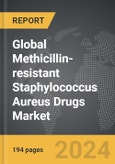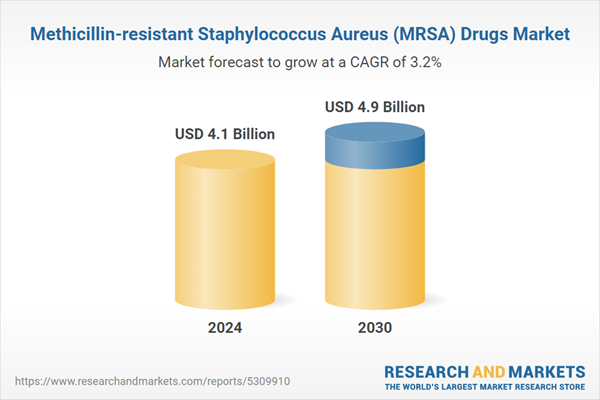Global Methicillin-Resistant Staphylococcus Aureus (MRSA) Drugs Market - Key Trends & Drivers Summarized
What Are Methicillin-Resistant Staphylococcus Aureus (MRSA) Drugs, and Why Are They So Crucial in Modern Healthcare?
Methicillin-Resistant Staphylococcus Aureus (MRSA) Drugs are medications specifically developed to treat infections caused by the MRSA bacteria, a type of Staphylococcus aureus that has become resistant to many commonly used antibiotics, including methicillin, penicillin, amoxicillin, and oxacillin. MRSA is known for causing severe infections, including skin and soft tissue infections, pneumonia, bloodstream infections, and surgical site infections, particularly in hospital settings (hospital-acquired MRSA or HA-MRSA) and community settings (community-acquired MRSA or CA-MRSA).The importance of MRSA drugs lies in their role in combating one of the most challenging and potentially deadly antibiotic-resistant bacteria. MRSA is associated with high morbidity, longer hospital stays, increased healthcare costs, and a significant risk of complications, including sepsis and organ failure. Effective MRSA drugs, which include newer antibiotics like vancomycin, linezolid, daptomycin, and ceftaroline, are essential in managing severe MRSA infections, reducing transmission, and preventing outbreaks. As antimicrobial resistance (AMR) becomes a global health crisis, the development and availability of effective MRSA drugs are critical to ensuring public health and maintaining the efficacy of antibiotic treatments.
How Are Technological Advancements Shaping the MRSA Drugs Market?
Technological advancements have significantly improved the development, efficacy, and delivery of MRSA Drugs, driving innovation in the treatment of drug-resistant infections. One of the major developments is the introduction of novel antibiotics that target specific mechanisms of MRSA resistance. For example, ceftaroline and dalbavancin have shown high efficacy against MRSA strains, offering extended-spectrum activity that targets resistant bacteria more effectively than traditional antibiotics. These drugs have improved treatment outcomes by reducing the duration of therapy and minimizing side effects, enhancing patient compliance.Advancements in rapid diagnostic technologies have further shaped the MRSA drugs market. New molecular diagnostic tools can quickly identify MRSA strains from clinical samples, enabling faster and more precise treatment decisions. Rapid diagnostics allow healthcare providers to initiate targeted antibiotic therapy sooner, improving patient outcomes and reducing the spread of MRSA. This has increased the demand for MRSA-specific drugs in both hospital and outpatient settings, where timely intervention is crucial to controlling infection spread and preventing complications.
The development of combination therapies has also enhanced MRSA treatment efficacy. Combination therapies often pair traditional antibiotics like vancomycin or daptomycin with adjuvants that enhance their effectiveness against MRSA. This approach helps overcome resistance mechanisms by disrupting bacterial defenses and improving drug penetration. Additionally, advancements in drug delivery systems, such as liposomal encapsulation and slow-release formulations, have improved the pharmacokinetics and bioavailability of MRSA drugs, leading to more effective and sustained antibacterial action. These technological innovations not only expand the capabilities of MRSA drugs but also align with broader trends toward precision medicine, improved diagnostics, and enhanced antimicrobial stewardship in modern healthcare.
What Are the Emerging Applications of MRSA Drugs Across Different Healthcare Settings?
MRSA Drugs are finding expanding applications across a variety of healthcare settings, driven by the need for effective treatment of resistant infections, reduced hospital stays, and improved patient outcomes. In hospital settings, MRSA drugs are widely used to treat severe infections, including bloodstream infections, pneumonia, and surgical site infections. Hospitals often rely on intravenous (IV) formulations of MRSA drugs like vancomycin, daptomycin, and linezolid for critically ill patients, providing rapid antibacterial action to control severe cases. Additionally, MRSA drugs are used as a preventive measure in high-risk patients, such as those undergoing surgery, dialysis, or receiving immunosuppressive therapy.In outpatient settings, oral MRSA drugs like linezolid and clindamycin are used to treat less severe MRSA skin and soft tissue infections, allowing patients to continue treatment outside the hospital. This not only reduces the risk of hospital-acquired infections but also minimizes healthcare costs associated with prolonged hospital stays. Outpatient antimicrobial therapy (OPAT) programs have been developed to facilitate the administration of IV MRSA drugs in outpatient clinics, making it easier for patients to receive necessary treatment without hospitalization.
In long-term care facilities, MRSA drugs play a critical role in managing outbreaks and preventing the spread of infection among vulnerable populations, such as elderly residents with compromised immune systems. Topical MRSA treatments, such as mupirocin, are used for decolonization, which involves eradicating MRSA carriage from the nasal passages and skin, thereby reducing the risk of infection transmission. In community healthcare, MRSA drugs are used to manage community-acquired MRSA (CA-MRSA) infections, which can affect otherwise healthy individuals, particularly those involved in close-contact activities like sports or living in crowded conditions. The expanding applications of MRSA drugs across these healthcare settings highlight their critical role in reducing infection rates, improving treatment outcomes, and supporting effective infection control strategies.
What Drives Growth in the MRSA Drugs Market?
The growth in the MRSA Drugs market is driven by several factors, including increasing incidence of MRSA infections, rising awareness of antimicrobial resistance, and ongoing advancements in antibiotic development. One of the primary growth drivers is the high prevalence of MRSA infections, particularly in hospitals, nursing homes, and other healthcare settings. As MRSA continues to cause severe infections worldwide, there is a sustained demand for effective MRSA drugs to manage and control these infections. This demand is further heightened by the rising rates of community-acquired MRSA, which affects both high-risk populations and otherwise healthy individuals, increasing the need for effective outpatient treatments.Rising awareness of antimicrobial resistance (AMR) has further fueled demand for MRSA drugs. As healthcare organizations, governments, and public health agencies prioritize the fight against AMR, there is a greater emphasis on developing new antibiotics and optimizing the use of existing drugs to treat resistant infections like MRSA. This has led to increased investments in antibiotic research and development (R&D), as well as efforts to promote the appropriate use of MRSA drugs to prevent the emergence of further resistance.
Supportive regulatory frameworks and incentives have also contributed to the growth of the MRSA drugs market. Regulatory agencies like the U.S. FDA and the European Medicines Agency (EMA) have introduced initiatives to encourage the development of new antibiotics, including fast-track approvals, priority review programs, and funding support. These measures aim to address the urgent need for novel treatments against drug-resistant pathogens, including MRSA. Additionally, public and private sector funding for AMR research, along with global health initiatives aimed at controlling resistant infections, has driven R&D efforts focused on MRSA.
With ongoing innovations in drug development, rapid diagnostics, and antimicrobial stewardship, the MRSA drugs market is poised for continued growth. These trends, combined with increasing demand for effective, targeted, and accessible treatments, make MRSA drugs a vital component of modern healthcare strategies focused on reducing AMR, improving patient outcomes, and managing the global impact of drug-resistant infections across various healthcare settings.
Report Scope
The report analyzes the Methicillin-resistant Staphylococcus Aureus (MRSA) Drugs market, presented in terms of market value (US$ Thousand). The analysis covers the key segments and geographic regions outlined below.- Segments: Distribution Channel (Hospital Pharmacy, Retail Pharmacy, Online Pharmacy); Drug Class (Lipopeptide, Oxazolidinone, Cephalosporin, Tetracycline, Other Drug Classes); Route of Administration (Oral, Parenteral).
- Geographic Regions/Countries:World; United States; Canada; Japan; China; Europe (France; Germany; Italy; United Kingdom; and Rest of Europe); Asia-Pacific; Rest of World.
Key Insights:
- Market Growth: Understand the significant growth trajectory of the Lipopeptide segment, which is expected to reach US$1.7 Billion by 2030 with a CAGR of a 3%. The Oxazolidinone segment is also set to grow at 3% CAGR over the analysis period.
- Regional Analysis: Gain insights into the U.S. market, valued at $1.1 Billion in 2024, and China, forecasted to grow at an impressive 3.1% CAGR to reach $791.7 Million by 2030. Discover growth trends in other key regions, including Japan, Canada, Germany, and the Asia-Pacific.
Why You Should Buy This Report:
- Detailed Market Analysis: Access a thorough analysis of the Global Methicillin-resistant Staphylococcus Aureus (MRSA) Drugs Market, covering all major geographic regions and market segments.
- Competitive Insights: Get an overview of the competitive landscape, including the market presence of major players across different geographies.
- Future Trends and Drivers: Understand the key trends and drivers shaping the future of the Global Methicillin-resistant Staphylococcus Aureus (MRSA) Drugs Market.
- Actionable Insights: Benefit from actionable insights that can help you identify new revenue opportunities and make strategic business decisions.
Key Questions Answered:
- How is the Global Methicillin-resistant Staphylococcus Aureus (MRSA) Drugs Market expected to evolve by 2030?
- What are the main drivers and restraints affecting the market?
- Which market segments will grow the most over the forecast period?
- How will market shares for different regions and segments change by 2030?
- Who are the leading players in the market, and what are their prospects?
Report Features:
- Comprehensive Market Data: Independent analysis of annual sales and market forecasts in US$ Million from 2024 to 2030.
- In-Depth Regional Analysis: Detailed insights into key markets, including the U.S., China, Japan, Canada, Europe, Asia-Pacific, Latin America, Middle East, and Africa.
- Company Profiles: Coverage of players such as Allergan PLC, Basilea Pharmaceutica Ltd., Merck & Co., Inc., Pfizer, Inc., The Medicines Company and more.
- Complimentary Updates: Receive free report updates for one year to keep you informed of the latest market developments.
Some of the 41 companies featured in this Methicillin-resistant Staphylococcus Aureus (MRSA) Drugs market report include:
- Allergan PLC
- Basilea Pharmaceutica Ltd.
- Merck & Co., Inc.
- Pfizer, Inc.
- The Medicines Company
- Theravance Biopharma, Inc.
This edition integrates the latest global trade and economic shifts into comprehensive market analysis. Key updates include:
- Tariff and Trade Impact: Insights into global tariff negotiations across 180+ countries, with analysis of supply chain turbulence, sourcing disruptions, and geographic realignment. Special focus on 2025 as a pivotal year for trade tensions, including updated perspectives on the Trump-era tariffs.
- Adjusted Forecasts and Analytics: Revised global and regional market forecasts through 2030, incorporating tariff effects, economic uncertainty, and structural changes in globalization. Includes historical analysis from 2015 to 2023.
- Strategic Market Dynamics: Evaluation of revised market prospects, regional outlooks, and key economic indicators such as population and urbanization trends.
- Innovation & Technology Trends: Latest developments in product and process innovation, emerging technologies, and key industry drivers shaping the competitive landscape.
- Competitive Intelligence: Updated global market share estimates for 2025, competitive positioning of major players (Strong/Active/Niche/Trivial), and refined focus on leading global brands and core players.
- Expert Insight & Commentary: Strategic analysis from economists, trade experts, and domain specialists to contextualize market shifts and identify emerging opportunities.
Table of Contents
Companies Mentioned (Partial List)
A selection of companies mentioned in this report includes, but is not limited to:
- Allergan PLC
- Basilea Pharmaceutica Ltd.
- Merck & Co., Inc.
- Pfizer, Inc.
- The Medicines Company
- Theravance Biopharma, Inc.
Table Information
| Report Attribute | Details |
|---|---|
| No. of Pages | 194 |
| Published | December 2025 |
| Forecast Period | 2024 - 2030 |
| Estimated Market Value ( USD | $ 4.1 Billion |
| Forecasted Market Value ( USD | $ 4.9 Billion |
| Compound Annual Growth Rate | 3.2% |
| Regions Covered | Global |









